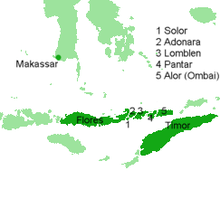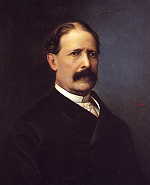Treaty of Lisbon (1859)
In the Treaty of Lisbon of April 20, 1859 , the division and exchange of Portuguese and Dutch possessions in the Solor and Timor archipelago between Portugal and the Netherlands were agreed. It was the first official agreement between the two colonial powers on the division of territory in Southeast Asia.
history
The Portuguese established the first posts and fortresses in the region in the 16th century. A hundred years later, the Dutch began to attack these Portuguese possessions and set up their own bases. The climax was the Dutch-Portuguese War (1624 to 1661), during which the Dutch, for example , conquered Kupang in West Timor . But even later there were always fights. In 1749 the Portuguese attempt to retake Kupang failed and almost all of West Timor was lost to the Dutch East India Company .
In 1851 the Dutch and Portuguese sent a commission to clarify the property disputes. In July, the Portuguese governor José Joaquim Lopes de Lima reached an agreement with the Dutch governor of Kupang Baron von Lynden in Dili on the colonial borders on the Lesser Sunda Islands . In it, the Portuguese claims to most of West Timor were finally given up in favor of the Dutch, for which the Dutch enclave Maubara in the east went to Portugal. In addition, the eastern part of Flores , Solor , Pantar and Alor were sold to the Dutch for 200,000 florins at the same time , but without authorization from the Portuguese government. The reason for the hurry was the acute lack of money in the colonial administration in Dili. The officials had not received a wage for two years, the warship Mondego was in need of repair and Lopes de Lima wanted to buy some schooners to get the trade going again. Therefore, he demanded an immediate payment of a first installment of 80,000 florins.
Governor Lopes de Lima fell out of favor and was dismissed when Lisbon learned of the treaty. Lopes de Lima died in Batavia on the return trip to Portugal . The Portuguese Setembrist government used the agreement to defame the previous cartistic government , to whose movement Lopes de Lima belonged, with success in public opinion. It was even rumored that Lima de Lopes fled to America with the money. But the agreements, viewed as a national disgrace, could not be reversed. In this case, the 80,000 Florins plus interest and the costs for the administration of the properties on Flores by the Dutch should have been repaid, which was not possible due to the dire financial situation of Portugal. In addition, Flores with its base Larantuka was not a lucrative colony. The income there of 50 rupees per year was not even enough to support the small military crew of six soldiers with six cannons in the small fort. The local ruler has even made common cause with Buginese pirates. In part, there was the assessment that the Larantuka estate would have had to be given up if Lopes de Lima had not sold it. And Portugal's military and political opportunities to regain possession of Larantuka were also questionable in view of the Dutch dominance in the region. From 1854 the agreements on the borders were renegotiated by the Portuguese Foreign Minister Visconde de Athoguoa and the Dutchman Linbourg van Rost . The secretary of the Portuguese delegation, Afonso de Castro, reports that the substantial amount of compensation that is likely to be paid in particular led the Portuguese to finally abandon Larantuka against the will of the government, public opinion and the press. However, Castro questioned the legality of these Dutch claims, since the treaty of 1851 was never ratified and the Dutch occupation of Larantuka was therefore invalid. In the treaty signed on October 6, 1854, Portugal nevertheless agreed to all points of the 1851 agreement.
However, the treaty of 1854 was rejected by the Dutch government. The reason was the question of denominations in the areas that should be exchanged. While the free practice of religion was contractually guaranteed in Catholic Flores, there was no such agreement for Protestants in Maubara. From 1858 a new round of negotiations followed, chaired by the Cartist Fontes Pereira de Melo , who later became Portuguese Prime Minister. Now Portugal demanded the cession of West Timor from the Netherlands to compensate for the loss of the other islands of the archipelago, as well as an undefined area in Africa . This can be taken as a sign of how important it was for Portugal to change the unpopular agreements of 1851, especially since Castro, despite his previously derogatory assessment of the properties in the Lesser Sunda Islands, now saw great advantages for his country should Portugal have an possession in the region, such as about the entire island of Timor. However, Portugal could not prevail, so that in the final conclusion of the treaty on April 20, 1859 in Lisbon no more territorial changes were made. Afonso de Castro took up the post of governor of Portuguese Timor that same year. Since the Cartists took over the government again in 1859, the ratification of the treaty was delayed until August 18, 1860. Fontes Pereira de Melo became Minister of the Interior in this government.
The treaty of 1859 had some weak points: with Maucatar and Noimuti , an enclave without sea access remained in the territory of the other side. In addition, the imprecise borders of the Timorese empires and their traditional claims formed the basis for the colonial demarcation. It was not until 1916, after three more rounds of negotiations, that the final borders on Timor were to be determined.
Contents of the Treaty of 1859
On the island of Timor, the new border was drawn across the island. The small Timorese empires on the Portuguese side of the border line were Cowa , Balibo , Lamaquitos (Lamakitu), Tafakay (Takay), Tatumea , Lookeu ( Laukeu ), Dakolo ( Dacolo ), Tamiru Eulalang (Eulaleng) and Suai .
On the Dutch side, the border areas were Juanilo , Silawang , Tialarang (Tialara), Lamaksanulo , Lamakanée (Lamacanée), Naitumu (Nartimu), Manden , Dirma (Drima) and Lakékune (Lakecune).
East of the border Timor belonged to Portugal, to the west to the Netherlands. However, there were still some enclaves on both sides. Maucatar (Calunie, Coluninene) remained under the sovereignty of the Netherlands, surrounded by the Portuguese empires Lamaquitos, Tauterine , Follofail (Folofaix) and Suai. In the west, Oe-Cusse Ambeno and Noimuti stayed with Portugal.
Portugal recognized the sovereignty of the Netherlands over the following kingdoms in Timor: Ambassi , Bibico (Traynico, Waymico), Buboque (Reboki), Dirma, Tialarang, Lamakanée, Nira (Lidak), Juanilo, Mena and Tulgarite (Tolgarita).
The Dutch ceded Maubara and Ambeno (Ambenu, Sutrana) to the Portuguese, and Dutch claims to the island of Atauro were given up.
For this, Portugal gave the following territories to the Netherlands: the kingdoms of Larantuka, Sikka (Sika, Sica) and Paga with their vassals on the island of Flores, the kingdom of Woure on the island of Adonara and the kingdom of Pamang Kaju on the island of Solor. Portugal had to give up claims to other empires on these islands and on the islands of Lembata (Lomblen), Pantar (Quantar) and Alor (Ombai). The Netherlands thus took control of this and the two other islands of the Solor Archipelago.
In compensation, Portugal was given the 80,000 Dutch florins that Governor Lopes de Lima had received in 1851. In addition, Portugal received another 120,000 Dutch florins.
Freedom of religion for the residents of the exchanged areas was guaranteed by both sides.
See also
supporting documents
literature
- Neil Deeley, Shelagh Furness, Clive H. Schofield: The International Boundaries of East Timor . International Boundaries Research Unit, Durham 2001, ISBN 1-897643-42-X , ( Boundary & territory briefing 3, 5), ( on Google book search )
- Monika Schlicher: Portugal in East Timor. A critical examination of the Portuguese colonial history in East Timor from 1850 to 1912 . Abera, Hamburg 1996, ISBN 3-931567-08-7 , ( Abera Network Asia-Pacific 4), (also: Heidelberg, Univ., Diss., 1994).
Web links
- James J. Fox: Out of the Ashes , Australian National University
- Geoffrey C. Gunn: History of Timor. , Technical University of Lisbon (PDF file; 805 kB)

